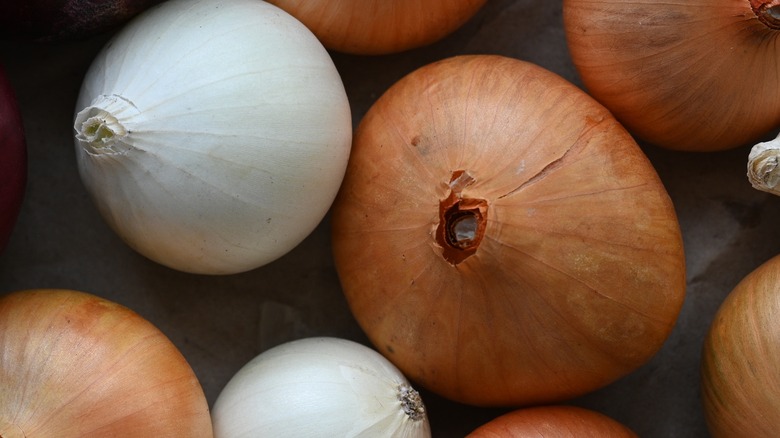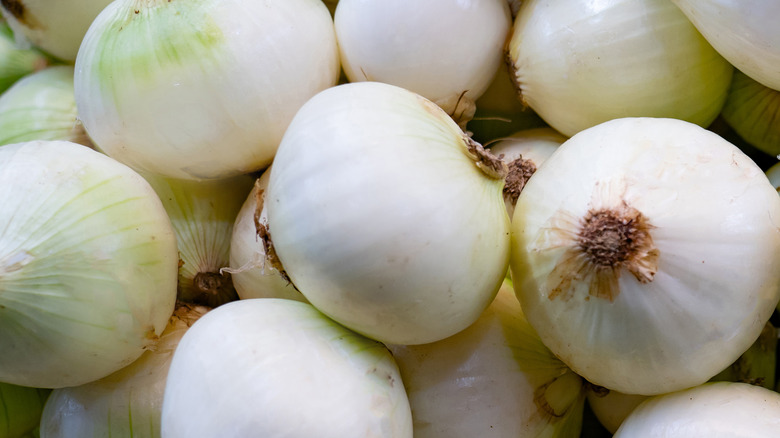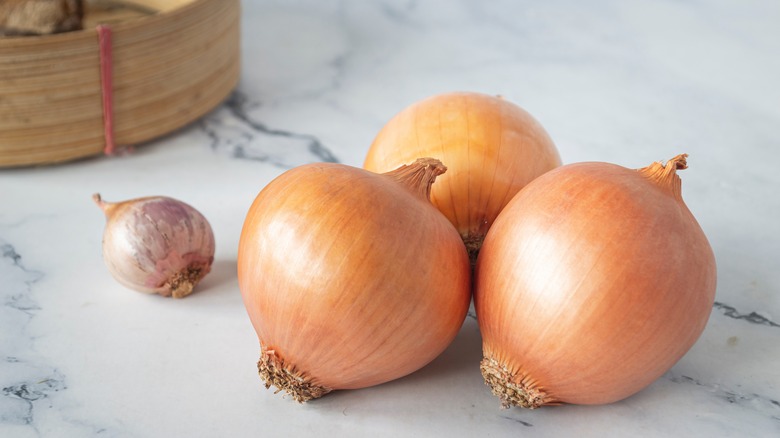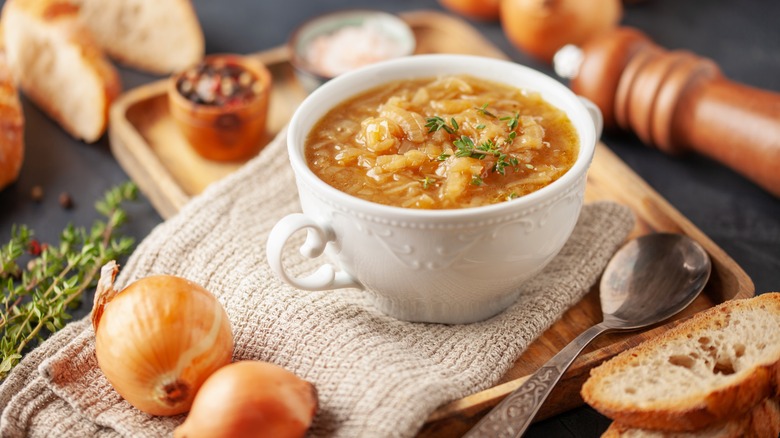How White And Yellow Onions Differ
Love 'em or hate 'em, there's little debate that the humble onion is the unsung hero of the culinary world. These unassuming root vegetables have been a significant source of hydration, vitamin C, and fiber for at least 5,000 years. Since that time, humans have developed literally thousands of recipes dependent on onions, hotly debating which varetals belong in certain dishes. Do yellow onions make the best French onion soup, or can you swap them for white? Are white and yellow onions even all that different?
The answer, it turns out, is both yes and no. While white and yellow onions have significant differences when it comes to taste, texture, and general culinary usage, there are some instances where it's okay to use them interchangeably. To do so properly, however, it's important to understand how it will affect the flavor and consistency of your dish, and that means knowing your onions inside and out.
What is a white onion?
White onions are root vegetables propagated from bulbs. You can harvest them throughout the spring, summer, and autumn, making them a reliable source of food throughout the growing season. They're easily identifiable by their iridescent, papery white skin that makes them look a bit like giant pearls. Under the skin are concentric layers of firm-yet-juicy flesh with a distinct, astringent aroma. When sliced, the layers fall easily away from each other to form neat ribbons or dice cuts, depending on how small you chop them.
Though white onions do have that signature sharp bite associated with alliums, they tend to have a milder, sweeter flavor profile than other onions. Their flesh is also more delicate, especially when cooked. They tend to become transparent and sort of "melt" when heated, but they also become sweeter. This means they're better as a flavoring element rather than a textural one, making them ideal for spicy foods, like chili and barbecue.
However, in raw applications, white onions can easily become central to any dish. Raw white onions retain their firmness, adding crunch, sweetness, and zip to a wide variety of recipes. They're most popular in dishes like salsa and classic pico de gallo, and as a garnish on things like tacos and burgers. White onions are also great for livening up a salad with tangy goodness, particularly those with sweet elements like strawberries or shredded carrots.
What is a yellow onion?
Yellow onions are also root vegetables grown from bulbs, with multiple layers of crisp, aromatic flesh. Their brittle, crinkly skin is usually dark amber in color, almost orange. Unlike white onions, yellow onions get their name solely from the color of their flesh, which is a pale, creamy yellow. They're also in season from spring until the cold sets in during late autumn, meaning you can enjoy garden-fresh batches of beautifully caramelized onions for longer.
While yellow onions are less astringent and slightly sweeter than the white variety, they tend to have a much more pungent scent and overall flavor. Eating a yellow onion raw usually leaves a virtually impermeable aftertaste that may linger for hours afterward. On the other hand, cooking yellow onions helps soften this strong flavor, bringing out the sugars for a deliciously balanced tanginess. These qualities make yellow onions the best choice for cooked dishes where you want a big burst of oniony goodness.
As mentioned, yellow onions are often the first choice when it comes to caramelizing, but they're also the star of hearty beef stews, braised chicken dishes, pizza toppings, and as the onion element in a mirepoix. The reason they hold up so well to heat and long cook times is due to their high starch content. The starches help yellow onions keep their shape as they become flexible, tender, and tantalizingly delicious.
Are white and yellow onions interchangeable?
Though white onions are typically recommended for raw applications and yellow onions are usually used in cooked dishes, you can swap them out for each other in a pinch. They're both onions, after all, and will impart similar flavors to foods that need a hit of sharpness to taste right. However, it's important to understand the differences between the two so you can anticipate how using a yellow onion instead of white (or vice versa) might change the outcome of your recipe.
For instance, if you're making salsa and only have a yellow onion, you can certainly use it to give your salsa bright acidity. Just be aware that, consumed raw, yellow onions are more pungent than white, so you may want to use a little less. You might also add a very small drizzle of honey or pinch of brown sugar, as sweetness can soften acidity.
Conversely, if you're making a stew or even French onion soup and only have white onions, you can still make the recipe. However, white onions will break down and become much softer than their yellow counterparts. They'll also impart less sharp onion flavor once cooked, so you may want to adjust your seasonings accordingly. For instance, if you have dried minced onions in your pantry, you can add some to your recipe to support the white onions' fresh flavor. You can also compensate with other seasonings like garlic powder or tajin.



